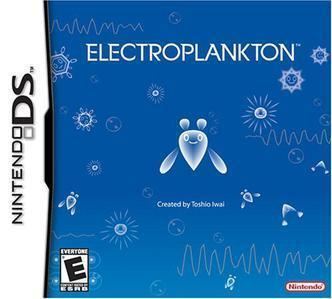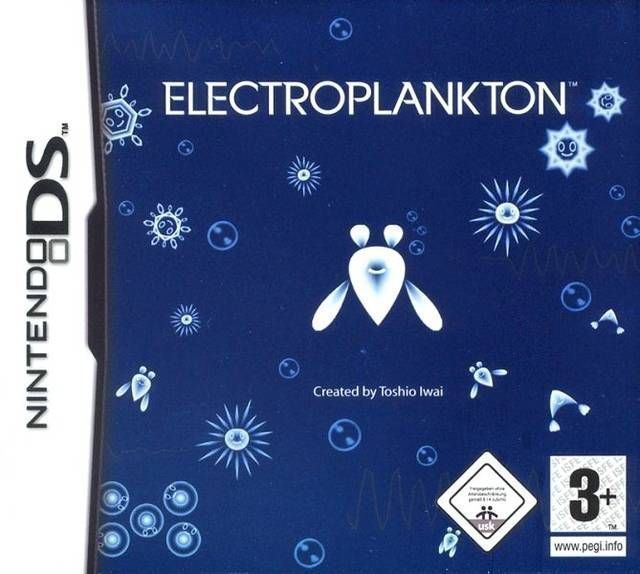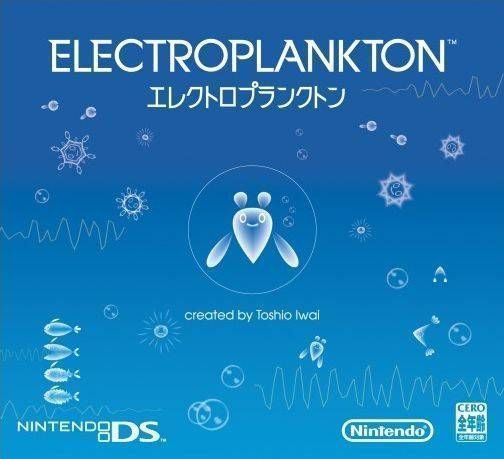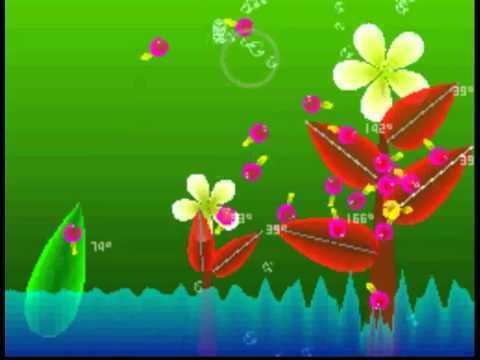7.8 /10 1 Votes7.8
7.3/10 GameSpot Initial release date 7 April 2005 | 4.5/5 Emuparadise 7/10 IGN | |||||||||||||||||||||||||||||||||
 | ||||||||||||||||||||||||||||||||||
Producer(s) Shigeru MiyamotoToru Osawa Artist(s) Nanako KinoshitaKazuma Norisada Composer(s) Koichi KyumaYuichi Ozaki Release date(s) JP: April 7, 2005NA: January 9, 2006EU: July 7, 2006 Awards BAFTA Games Award for Use of Audio Similar Toshio Iwai games, Music video games, Other games | ||||||||||||||||||||||||||||||||||
Electroplankton (エレクトロプランクトン, Erekutoropurankuton) is an interactive music video game developed by indieszero and published by Nintendo for the Nintendo DS handheld video game console. It was first released in Japan in 2005, and was later released in North America and Europe in 2006. This game allows the player to interact with animated plankton and create music through one of ten different plankton themed interfaces. The first-run edition of Electroplankton in Japan came bundled with a set of blue colored ear bud headphones.
Contents
- Nintendo ds electroplankton music 10 apples for 5
- Gameplay
- Development
- Release
- Release as DSiWare
- Reception
- Legacy
- References

Nintendo ds electroplankton music 10 apples for 5
Gameplay

The game offers two game modes — Performance and Audience. The Performance mode allows the user to interact with the plankton through use of the stylus, touchscreen, and microphone. Audience mode simply allows the user to put down the system and enjoy a continuous musical show put on by all of the plankton, although the user can interact with the plankton just like in Performance mode. Audience mode is like a demo mode in some other games.
Development

Nintendo president Satoru Iwata explained that the unusual reason why director Toshio Iwai's name appears directly on the game's packaging is because he alone had created it. The developers considered including a save function, but opted not to because they wanted for the players to enjoy the game both extemporarily and viscerally. They felt that if a save function were included then the game would be used more as a tool, where the player had to open several additional menus and windows or have to input file names to save. Another reason was that it would require large volume of flash ROM and would take a long time to save and read the data in order to save the voice files for Volvoice and Rec-Rec.
Release

The title made its first public appearance at the 2005 Game Developer's Conference, and later, an appearance at the 2005 E3 show. On October 19, 2005, Nintendo revealed Electroplankton's release date in North America: January 9, 2006, with sales of the game limited to online retailers and the Nintendo World store in New York City, though some retailers may carry the game if they choose to. For example, Electronics Boutique carried the game when it was released in Canada. It was released in Europe on July 7, 2006.

A release was planned by Nintendo Australia in late 2006 but never eventuated due to, according to NoAus representatives, not enough space in the release schedule.
Release as DSiWare
On July 6, 2009, Nintendo announced that Electroplankton would be re-released in Japan, as part of the DSiWare service exclusive to the Nintendo DSi system. Each "instrument" is available to buy separately for 200 Nintendo Points each.
Tracy (renamed Trapy), Hanenbow, Nanocarp, and Beatnes were released on July 11, while Rec Rec and Lumiloop were released on July 22. Luminaria and Sun Animalcule were released August 5, and Marine Snow and Volvoice were released August 26, 2009.
In North America, all 10 Electroplankton were released in November 2009. Trapy, Hanenbow, Rec-Rec, Nanocarp, and Beatnes were released on November 9, while Luminaria (renamed Luminarrow), Sun-Animalcule, Lumiloop, Marine-Snow (renamed Marine-Crystals), and Volvoice (renamed Varvoice) were released November 23.
In the PAL region, the first two Electroplankton were released on January 15, 2010, which were Beatnes and Hanenbow. The next two were released on January 22, 2010, which were Nanocarp and Trapy. The next two released were Luminarrow and Sun-Animalcule on January 29, 2010. Rec Rec and Lumiloop were added on February 12, 2010 and the last two minigames Marine-Crystals and Varvoice, were released on February 26, 2010.
Reception
Joystiq gave it 8.0 out of 10. Nintendo Power gave it 8.5 out of 10. IGN gave it 7.0 out of 10. Official Nintendo Magazine gave it 78%.
Kidzworld said that one of the most common complaints concerning Electroplankton is that the game offers no true way to save the audio created by the player. Absolutely no data is recorded onto the game cartridge at any time, which can be frustrating to a player who manages to compose a particularly elaborate or quality piece. Although this problem can be overcome by connecting an audio recording device, such as a cassette recorder or a personal computer, to the headphone jack of the Nintendo DS, this solution is not practical for the average player.
Legacy
Electroplankton is represented in Super Smash Bros. Brawl with its own stage called "Hanenbow" that is based on the Hanenbow feature.
